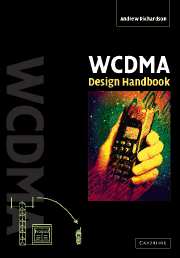Book contents
- Frontmatter
- Dedication
- Contents
- Preface
- Acknowledgements
- List of abbreviations
- 1 Introduction
- 2 WCDMA in a nutshell
- 3 Spreading codes and modulation
- 4 Physical layer
- 5 RF aspects
- 6 Chip rate processing functions
- 7 Symbol rate processing functions
- 8 Layer 2 - medium access control (MAC)
- 9 Layer 2 - RLC
- 10 PDCP and BMC protocols
- 11 Layer 3 - RRC
- 12 Measurements
- 13 NAS
- 14 Idle mode functions
- Appendix
- References
- Index
1 - Introduction
Published online by Cambridge University Press: 05 October 2013
- Frontmatter
- Dedication
- Contents
- Preface
- Acknowledgements
- List of abbreviations
- 1 Introduction
- 2 WCDMA in a nutshell
- 3 Spreading codes and modulation
- 4 Physical layer
- 5 RF aspects
- 6 Chip rate processing functions
- 7 Symbol rate processing functions
- 8 Layer 2 - medium access control (MAC)
- 9 Layer 2 - RLC
- 10 PDCP and BMC protocols
- 11 Layer 3 - RRC
- 12 Measurements
- 13 NAS
- 14 Idle mode functions
- Appendix
- References
- Index
Summary
Concepts and terminology
This book is concerned with an exploration of the design and operation of a technology referred to as wideband code division multiple access (usually abbreviated to WCDMA or W-CDMA).
Before starting the journey exploring the design and operation of the WCDMA technology, we first need to define what we mean by WCDMA. To do this, it is useful to examine first the terminology that surrounds the WCDMA system and which is put into context in Figure 1.1. To understand the diagram, we need to start at the outer ring.
The outer ring encompasses all of the technology that is viewed as being part of the third generation (often shortened to the term 3G) of mobile phone technology. This third generation follows (obviously) from second-generation (2G) technologies such as: the Global System for Mobile (GSM)communications, which is deployed in Europe and many other countries throughout the world; IS54/IS136, which is a 2G standard developed in the USA and also used in a number of countries throughout the world; Personal Digital Cellular (PDC) developed and deployed in Japan; and IS95, the USA developed CDMA standard, which is deployed in the USA and many other countries.
3G is a term used to reflect a number of different technologies being defined as successors to 2G technology. In many cases, the 3G technologies can be seen as an evolution of the 2G networks. Another general term for 3G is International Mobile Telecommunications 2000 (IMT2000).
- Type
- Chapter
- Information
- WCDMA Design Handbook , pp. 1 - 23Publisher: Cambridge University PressPrint publication year: 2005



